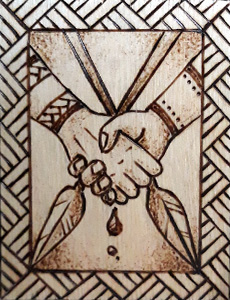 Æsir Basics
Æsir Basics
The Æsir are a tribe of gods descended from Borr, who’s father was Búri, the ancestor of the gods who was licked from the ice by the sacred cow, Auðumbla. Borr married Bestla, a jötunn descended from the first being, Ýmir, the primal frost giant. The myths record that Boor and Bestla had three children: Óðin, Vili, and Vé. Thus the entire race of gods was spawned.
As the creation myths progress, a third tribe is introduced – the Vanir – and no description is given of their origin. We can assume that they also originated from Búri, as he was the first non-giant to manifest in the ice, but we have no recorded lineage for this second tribe.
The Æsir are distinct from the Jötnar and the Vanir, but any of these tribes who married an Ás (the singular form of Æsir) was also deemed Æsir. In this sense, the Æsir were the unified family of gods who ruled Ásgard.
In the myths, the Æsir and the Vanir tribes waged wars against each other, until it was determined that neither side could best the other. Peace was struck between the two enemies, and hostages were exchanged to solidify the peace treaty. The god Kvasir was formed by Óðinn out of the combined spit of the two tribes used to seal the deal.
In Gylfaginning of the Prose Edda, written by Snorri Sturluson, twelve male Æsir are attested:
- Thor, son of Óðin and Jörð. Guardian of Miðgarðr.
- Baldr, son of Óðin and Frigg. God of peace and beauty.
- Höðr, Baldr’s blind twin. God of the unknown.
- Njörðr, a Vanir and god of the sea.
- Freyr, son of Njörðr, and also a Vanir. God of fertility.
- Týr, god of war and law, who’s parentage is uncertain.
- Bragi, son of Óðin and Gunnlöð. God of music and poetry.
- Heimdallr, guardian of Bifröst. Unknown parentage.
- Víðarr, son of Óðin and Gerð. God of silence.
- Váli, son of Óðin and Rindr. God of vengeance.
- Ullr, son of Sif and an unknown father. God of archery, skiing, and single combat.
- Forseti, son of Baldr and Nanna. God of justice and arbitration.
Though not listed here, Óðin himself and Loki are also considered a part of the ruling family. Óðin is usually the elected head of the gods of Ásgard, deferred to in most matters requiring action. Loki is a companion to Thor, somehow shares an oath with Óðin, and is a featured character in much of the lore. Snorri Sturluson makes a point to note that he has not been listed because of the misery he brings down upon the gods later.
In response to this list, fourteen female gods, or Ásynjur, are named:
- Frigg, daughter of Fjörgynn and Jörð. Goddess of marriage and the home.
- Freya, daughter of Njörðr and also a Vanir. Goddess of fertility.
- Eir, a handmaid of Frigg. Goddess of healing.
- Sága, a handmaid of Frigg. Goddess of literature and history.
- Gefjion, a handmaid of Frigg. Goddess of women.
- Fulla, a handmaid of Frigg. Goddess of secrets.
- Sjöfn, a handmaid of Frigg. Goddess of siblings and family relations.
- Lofn, a handmaid of Frigg. Goddess of unconventional marriages.
- Var, a handmaid of Frigg. Goddess of oaths and contracts.
- Vör, a handmaid of Frigg. Goddess of visions.
- Syn, a handmaid of Frigg. Goddess of boundaries and security.
- Hlín, a handmaid of Frigg. Goddess of children.
- Snotra, a handmaid of Frigg. Goddess of social etiquette.
- Gná, a handmaid of Frigg. Goddess of communication.
There are, of course, many additional gods and goddesses who join the Æsir family and are attested by Snorri, so it’s not certain why this list in the early portion of the Edda is limited to just fourteen gods of each gender. Conspicuous is the absence of some very important goddesses, including Iðunn, the wife of Bragi, and Sif, the wife of Thor – both of whom play starring roles in their own stories. Then there is Skaði, who marries into the pantheon through Njörðr, and Baldr’s wife Nanna, who dies at his funeral and returns with him after Ragnarök. Sól and Máni, the female sun and the male moon respectively, are also important characters in the Æsir pantheon, and Mímir as well.
Some children of the gods are listed (such as Ullr, Bragi, and Thor) but others are not, including Móði, Magni, and Þrúðr, children of Thor, and Hermóðr, another son of Óðin. Óðin’s brothers, Vili, Vé, and Hœnir are also left out.
The Æsir were self-appointed guardians of humankind, striving to care for and support them. After creating Miðgarðr from the slain body of their foe, Ýmir, the three brothers – Óðin, Vili, and Vé – create a perimeter to keep Jötunheimr separate from the delicate new world. They come upon a couple of ash and birch driftwood logs, and create the first man and woman. Each of the brothers endows the new beings with a special gift, and they set them loose on the fertile Earth, watching over their progress through the ages.
It is to Óðin’s sorrow that he learns of the future destruction of the gods, not only for his own Æsir family, but also his human children. When the great wall of Ásgard is sundered and when Thor’s hammer, Mjölnir is stolen, Óðin laments that the gods should be unable to protect Miðgarðr from the Jötnar, and the righting of these wrongs becomes a great priority for the entire pantheon.
ydalir.ca
Signs and Symbols
Gold, blue, and white. Sky and inclement weather themes. The rune Óss.
ydalir.ca
Associated Names
Óss, Áss, Ás, Ásynja, and Ásynjur
